Install Garden Lighting Cost
Last updated 11th June, 2025
If you’ve recently had your garden remodelled but something is still not quite right, you may be missing a key component: garden lighting. Not only can a few extra lights help enhance your garden’s ambience, they can also serve as security solutions by increasing visibility at night.
Whether it’s DIY-friendly solar lights, perfect for lighting up garden paths, energy-efficient yet bright LED bulbs, or low-voltage systems, commonly seen in landscape lighting installation, there’s bound to be a lighting solution that’s perfect for your outdoor space and needs.
Garden lighting can cost as little as £10, or more complicated lighting can cost over £450.
In this article, we’ll examine everything related to outdoor lighting, from installation to timeframes, the different types of garden lighting, and how you can find and hire a professional to do the job.
Let’s go!
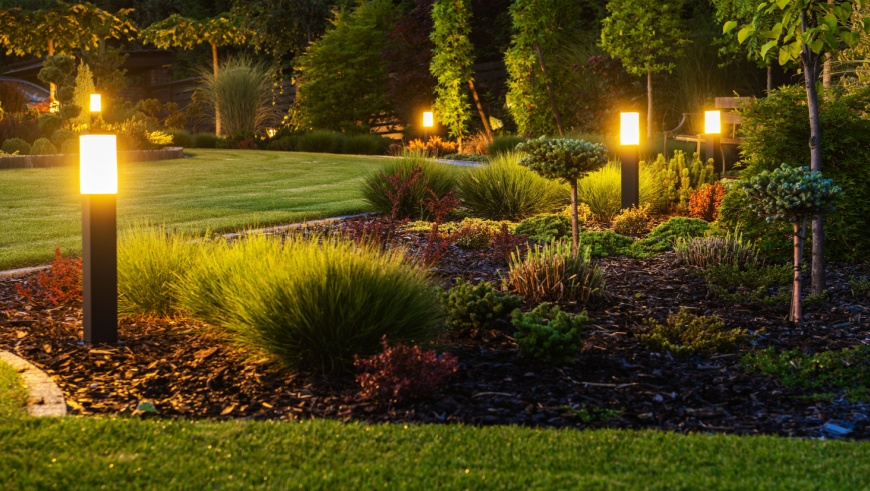
Table of Contents
- How much does garden lighting installation cost?
- Garden lighting installation prices
- Additional costs
- Labour costs and time frames
- Advantages and disadvantages of different types of garden lighting
- Steps for installing garden lights
- DIY outdoor light installation
- Seasonal outdoor lighting installation
- Compliance and regulations
- FAQs
- Finding and hiring a professional
- Sources
How Much Does Garden Lighting Installation Cost?
Garden lighting comes in many different forms–which means there will definitely be a type that suits your needs. The main varieties you’ll come across are:
- Solar-powered garden lights - £10 to £200+
- Wired garden lights - £120 to £200+
- LED garden lights - £350 to £450+
Solar-powered garden lights are a great DIY-friendly option for homeowners who want a quick, hassle-free solution to brighten up their garden. They can range from simple “stake” designs, which can be inserted into the ground to illuminate a pathway, for example, and can stretch to more elaborate designs such as festoon string lights, strip lights that wrap around your whole garden, or intricate designs like hanging tree or ball illuminations.
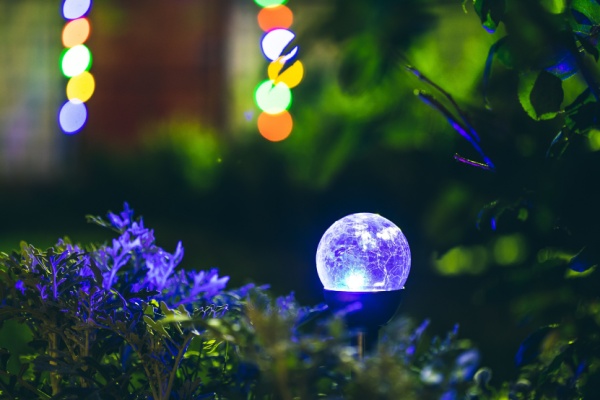
These lights don’t require any hard electrical wiring, making them a great choice for DIY enthusiasts who want a quick fix. However, this means they can be a little temperamental if you don’t have a great deal of sunshine, as they are powered by the sun.
If you want something more reliable and suitable for use all year round (no matter the level of sunshine you receive), wired garden lights are a great solution. Unlike solar-powered lights, wired garden lights need to be installed by an electrician as they are mains-powered. As you’d expect, they are available in a range of styles and designs to suit your outdoor aesthetic, from elaborate faux streetlight styles to more simple light bulb strips, or firefly festoon bulbs.
Similar to wired garden lights, you can opt for an LED bulb instead to give an energy-efficient glow. This allows you to achieve a consistent outdoor glow with a lower carbon footprint while saving money on your energy bills at the same time. LED garden lights come in a range of designs and styles, from festoon bulbs to upright stakes, as well as fairy lights to create a whimsical feel.
The cost of your outdoor lighting installation will depend on a few factors:
- The type and quality of your chosen lighting (e.g. mains-powered being generally more expensive than solar)
- The complexity of the installation (e.g. any wiring and landscaping needs)
- The size of the area
It’s important to consider these factors when calculating representative costs, as lighting a large garden across multiple levels will cost more than lighting a small balcony with a few festoon bulbs, for example.
With that in mind, let’s take a closer look at some installation prices.
Garden Lighting Installation Prices
To give you an idea of the budget you may need for your garden lighting project, we’ve collected some estimated costs, considering different types of lighting installations:
| Type | Total Estimated Cost (Supply and Labour) |
|---|---|
| Low-voltage outdoor lights | £120 to £200 |
| LED light cluster (10 lights) | £350 to £450 |
| Solar-powered garden lights | £10 to £200 |
| Landscape lights | £80 to £1,100 |
| Outdoor security light (30-watt) | £150 to £200 |
| Floodlights | £80 to £180 |
Low-voltage outdoor lights can cost between £120 and £200, depending on the scale of your desired installation and lighting style. They are typically cheaper than other types of wired outdoor lights, as the lower voltage means they use less energy and as a result, aren’t as bright. This makes them a good cost-effective choice if you’re on a budget.
A cluster of 10 LED lights can cost between £350 and £450, again depending on the exact style and design. LED bulbs are incredibly energy-efficient, meaning your carbon footprint will be reduced compared to traditional bulbs. They also shine brightly, which can give you a great burst of illumination if you have a particularly dark outdoor space.
Solar-powered outdoor lights are incredibly easy to install yourself as a DIY project and require no electrical wiring, helping to keep installation costs down. As they are powered by the sun, they can be less reliable than hard-wired outdoor lights, but they can be a good choice if you have a lot of sunshine and just want a subtle glow to illuminate a pathway, for example. These cost as little as £10 and can rise to £200+ for more ornate creations.
Landscape lights come in many different shapes and sizes, from pathway lights to LED ground lights and decking light solutions, giving you ample choice, costing as little as £80 for supply and installation. They are typically bright and work well to light your home and surroundings, acting as a layer of security–however, they can be expensive to run if you keep them on for long periods of time.
Speaking of security, a 30-watt security light will cost around £150 to £200, depending on the exact model. As the name suggests, these give a bright burst of light suitable for deterring unwanted visitors. Similarly, floodlights work in a comparable way and cost between £80 and £180.
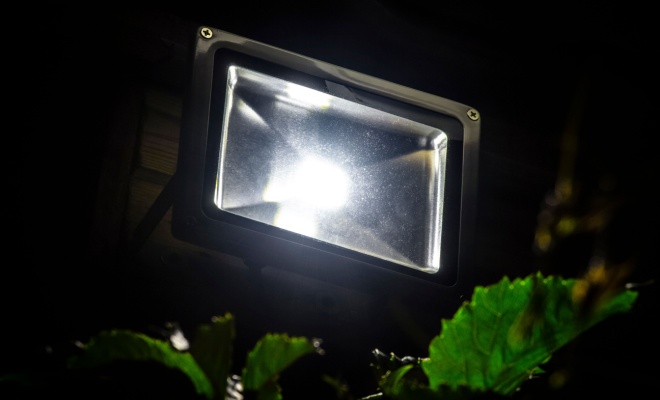
As we’ve mentioned, some outdoor lighting solutions are suitable for DIY installation. Let’s look at some supply-only costs to put that into perspective:
| Type | Supply Cost Only |
|---|---|
| Landscape lights | £2 to £1,000 |
| Floodlights | £4 to £80 |
| Motion sensor | £10 to £50 |
For supply-only, landscape lights can cost as little as £2, while some floodlights can start at just £4. Motion sensors are typically cheap, too, starting at £10.
It’s important to note that any electrical installation should be completed by competent electricians only to avoid the risk of electrocution. If you are unsure about electrical wiring, do not attempt it yourself–it’s best to hire a professional electrician to do the job safely and efficiently.
Additional Costs
As with most home renovation jobs, one small task will inevitably turn into a much bigger project–and lights for the outside is one of those “small” tasks.
Garden Maintenance
If you’re planning on spending more time outside–and especially once you’ve had lights installed–any imperfections will be all the more obvious. This might mean you want to have some garden maintenance undertaken.
Regular garden maintenance can cost between £30 and £50 to maintain an already well-kept garden. However, for vastly overgrown or unkempt spaces, the cost will be in the region of £200 to £250 per day, with an added charge for waste clearance of around £40 to £70 per hour.
Patio and Decking Installation
Perhaps you want a solid spot to sit and enjoy a drink after work in the summer evenings? If your garden doesn’t already have a patio or decking, it might be a good idea to have that work booked in around the same time as your garden light project to revamp the entire space at once.
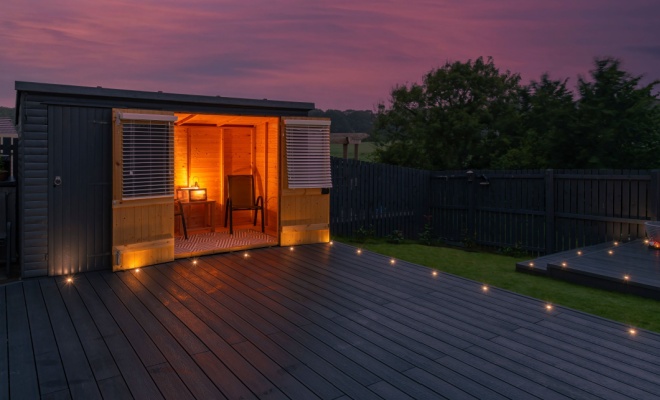
Installing a garden patio costs around £800 to £1,500, depending on the size and scope of the design. Decking is slightly more expensive, starting at £900 and rising to £4,400 and beyond, depending on the size and quality of your chosen decking.
Fencing Repairs
Maybe your garden fences have seen better days–eight wooden fence panels can cost in the region of £1,500 to £2,000 depending on the wood’s quality, while metal panels can command £1,600 to £2,400. You can opt for a supply-only approach to fencing, with panels costing anywhere from £15 to £80 depending on the style (lap being cheaper than tongue and groove, for example), if you feel capable of taking on the labour yourself.
Tree Pruning
Overhanging trees are a burden in gardens, especially if you have quite a few to maintain. Tree surgery is a highly skilled trade and not something you should attempt yourself, so it’s always best to hire professionals to take care of the work for you.

Daily rates start at £150 and rise to £200 for more experienced surgeons, but you will normally need more than one surgeon on site, bumping your overall costs up to around £450 to £600 per day.
Cost Breakdown Calculator
The total cost of large-scale outdoor landscape lights (labour and supply): £1,100
Supply
£1,000
Labour
£100
Waste removal
£100
Labour Costs and Time Frames
Electricians commonly charge between £150 to £200 per day of work. Depending on the scale of your electrical installation, the cost for outdoor light installation is most likely to be between £75 and £100, with higher costs associated with more complex installations.
It’s common to see these labour costs rolled into the total estimated price from a supplier, including the lighting supply costs, so be sure to check this in your quotation to ensure you know exactly what’s included. This will save you from encountering pesky added extras that you weren’t initially aware of.
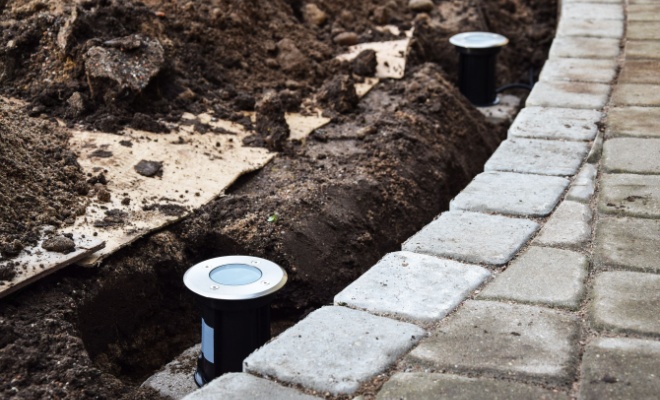
Installing garden lights is a relatively quick process, generally taking around half a day, but the timeframe can extend for more complex tasks. For instance, if you have a vast garden that requires complex wiring set-up, the timeframe is likely to be longer than it would be for a simple small garden set-up on one level.
Advantages and Disadvantages of Different Types of Garden Lighting
By now, we have a fairly good idea of the different types of outdoor lighting, but how can we narrow down those choices to find the best solution for your outdoor space?
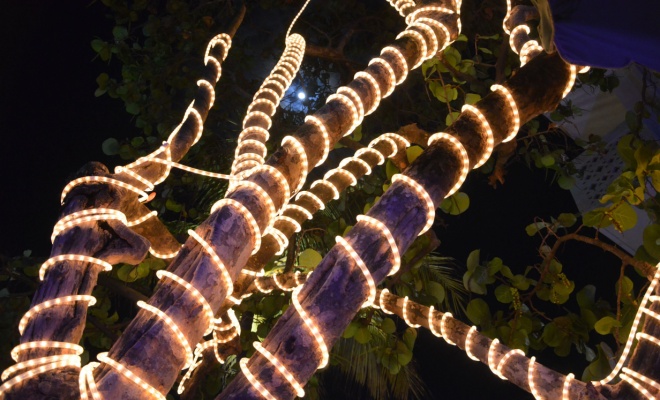
Take a look at our pros and cons to get better acquainted with the different types and their respective features:
| Type | Advantages | Disadvantages |
|---|---|---|
| LED outdoor lights | Energy-efficiency: LED lights are far more efficient than halogen or incandescent bulbs, giving energy-saving benefits | High cost: LED bulbs, as a result of their benefits, carry high installation costs |
| Longevity: LED bulbs are superior in lifespan to the aforementioned bulbs, lasting between 25,000 and 50,000 hours | Colour temperature: LED bulbs are commonly bright, harsh lights–which might not be preferential for all homeowners | |
| Durability: LED bulbs are durable and able to withstand harsh outdoor conditions | Compatibility issues: Some LED bulbs aren't suitable for existing fixtures (such as those designed for incandescent bulbs, for example) | |
| Mains-powered outdoor lights | Reliability: Being mains-powered, these will be far more reliable than solar-powered lights, for example | Requires professional installation: Mains-powered lights aren't suitable for DIY installation, making the overall installation costs higher |
| Versatility: Mains-powered lights are available in a range of designs and styles, suitable for any garden space | Energy costs: Mains-powered also means electrical running costs | |
| Brightness options: You can adapt the brightness of mains-powered outdoor lights to suit your specific needs, rather than just being set at one setting | Maintenance: Broken bulbs or damaged wires will need prompt action to be replaced or repaired by a professional electrician | |
| Solar-powered outdoor lights | Low installation fees: Solar-powered lights are incredibly cost-effective, with low supply costs | Less reliable: Solar-powered lights work by absorbing the sun's rays–if there is no sun, there is no light |
| DIY-friendly: What's more, they are DIY-friendly as they require no electrical cabling | Regular maintenance: To keep solar-powered lights working, they will need routine maintenance to keep them free of grime and dirt | |
| Adaptability: Because they have no wires, solar-powered lights can be placed practically anywhere, making them incredibly adaptable | Battery life: Solar-powered lights have limited lifespans and will require replacements after the 3-year mark |
Steps for Installing Garden Lights
When your contractor comes to your property to install your mains-powered garden lights, the steps they’re most likely to take are as follows:
- Switch off the electrical supply
The first and most important task is for your contractor to turn off the electrical supply. This ensures the work can begin safely. - Work area preparation
Work will then begin to clear the space ready to install the outdoor lighting. In order to save time and money, ensure your garden is cleared in advance so your electrician can get started straight away. Where necessary, other preparation may involve drilling holes or putting up wall brackets. - Connect the wires
After threading them through, your contractor will connect the cables with their respective terminals before securing them with PVC electrical tape. - Light fitting
At this stage, things start to take shape as the lights are fitted. They will take time to ensure the fitting is flush to the surface, and sealant will likely be applied to keep it secure. - Light switch installation
The light switch will then be installed, with the electrician ensuring the cables are connected properly to ensure proper earthing. - Testing the lights
Once the contractor is happy with the electrical installation, they will check the lights work. If there are any issues, they’ll be rectified at this stage before the electrical supply is fully restored.
As we’ve previously mentioned, any electrical work for garden lighting installation needs to be carried out by a professional, qualified electrician. As such, do not attempt this work by yourself.
DIY Outdoor Light Installation
Solar-powered outdoor lighting is the only type suitable for DIY projects, as it doesn’t require any electrical wiring. With these installations, you can easily unbox and insert them into the ground, or mount as necessary.
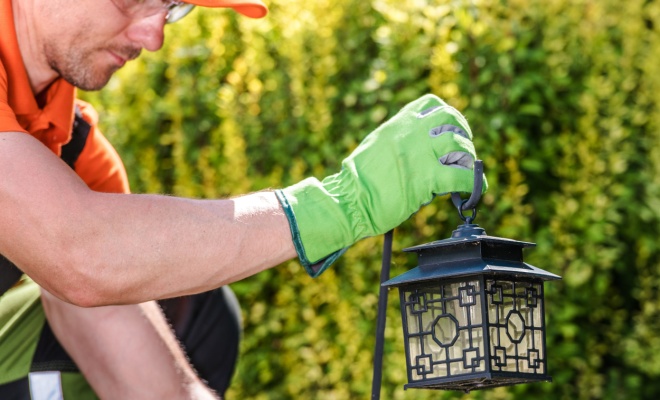
If you have outdoor lighting that requires mains power, it’s recommended that you hire a professional electrician to carry out the work for you to ensure it is completed safely. There are obvious risks involved with working with electricity, and these can be mitigated by handing the work over to a professional with ample experience.
Tips for Installing Outdoor Lighting
When installing outdoor lighting yourself remember to plan your layout first, especially if you need to check you have enough for your project. Consider whether they’re decorative or functional, it could be you want them to brighten up a garden feature or act as a source of light when it gets dark at night.
Whatever the reason, choose the correct lighting for your needs. For example, solar-powered may be eco-friendly but will they attract enough sun long enough to provide sufficient energy?
If you are using mains-powered lighting, only use waterproof and UV-resistant cables and lighting specifically designed for the outdoors. You can also use timers or motion sensors to help limit when the lights come on and off.
Remember, safety comes first, especially if you want to install outdoor lighting that runs off the main electricity supply. Always turn off the power when installing electrical lights and only do so in dry conditions to avoid any potential hazards.
Seasonal Outdoor Lighting Installation
With holidays and special events, seasonal outdoor lighting offers a temporary setup generally designed to focus on being decorative rather than necessarily practical.
This type of outdoor lighting is often easier to install, so they can be taken down after the festivities. Although, they sometimes require a certain amount of maintaining year-on-year as often aren't as durable as permanent lighting.
At times such as Halloween or Christmas, outdoor lighting displays can create a fun atmosphere around the home and garden. However, with large displays in particular, it’s important to be aware of the running cost.
This cost should be taken into consideration when purchasing even if only for a specific time of year. LED lights are often cheaper than traditional incandescent bulbs, however, intricate designs or colour-changing patterns may be less energy-efficient.
Compliance and Regulations
In most cases, the installation of garden lighting isn’t a notifiable activity and doesn’t require planning permission. The work, however, needs to be carried out by a qualified electrician if you are having wired lighting installed, as it will need to meet regulations and electrical standards.
You should receive an electrical installation certificate (EIC) to show the work was carried out lawfully and competently. The electrician should also notify the local council about the work.
Rules and regulations may differ in conservation areas or within listed property boundaries, and should be looked into on an individual case-by-case basis in these instances to ensure what you are having done isn’t in breach of any guidelines.
FAQs
Wired lights will have ongoing running costs, but the type of bulb you choose will dictate the actual costs. LEDs are more cost-effective than older lighting types as they are more energy-efficient, requiring less energy to run while creating a bright glow.
Finding and Hiring a Professional
While some outdoor lighting installations (such as solar-powered lights with no electrical wiring) can be completed yourself, it’s recommended that you hire a professional electrician to do the work when it comes to mains-powered lights.
It might be tempting to jump straight in with the first trader you receive a quote from, as we all want our gardens to look their best. However, it’s still prudent to carry out some due diligence before signing a contract. First, take a look at the trader’s credentials: Are they experienced in outdoor light installations, and for how many years?
Ensure they have relevant experience that can be related to your project. While they might be good at one particular speciality, it’s best to find someone who fits your full project’s scope to ensure a good result. Look at any before and after photographs or videos the trader has on their website or profile, as this will give you a good idea of the type of finish you can expect.
Working with electricity means adhering to electrical regulations. Ask the trader to ensure competence in this area–if they show hesitancy about regulations, it’s best to avoid them.
Aim to gather at least three different quotes to compare. Be wary of suspiciously cheap prices with immediate availability, as this can be the sign of a rogue trader or someone who might be willing to cut corners to get the job done as quickly and cheaply as possible.
Lastly, be sure to ask if the trader offers warranties or guarantees on their work–it’s best to find out what will happen if the lighting fails and if they will come back out to fix it at no charge.
Sources
https://theartoflight.co/further-knowledge/is-garden-lighting-notifiable/









